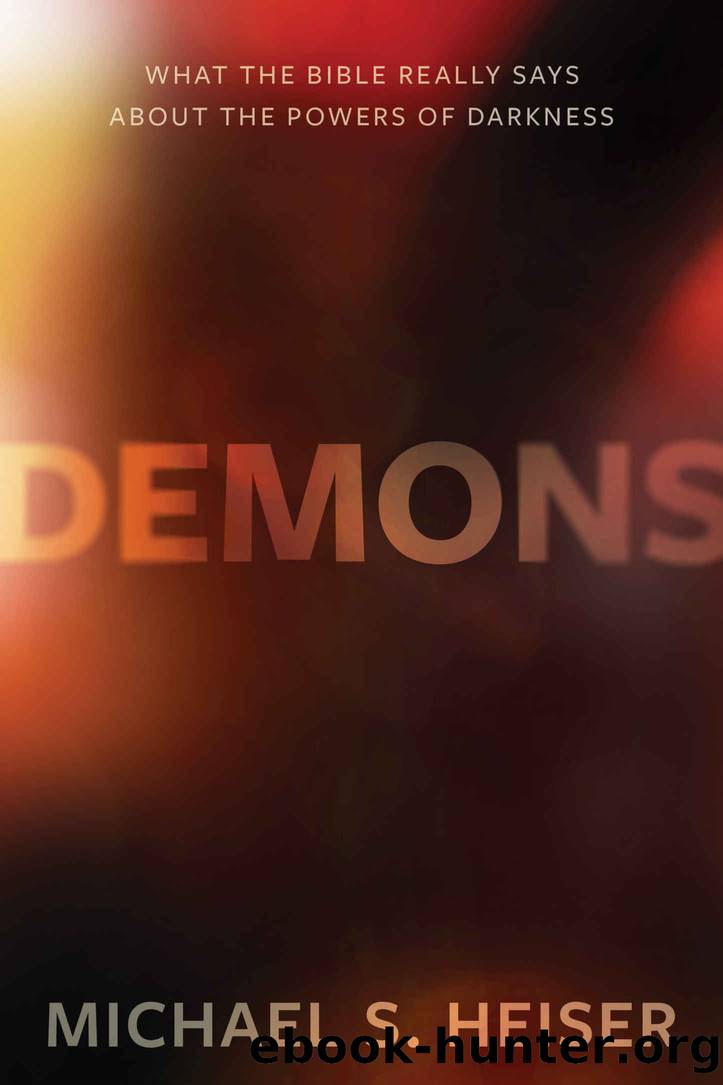Demons: What the Bible Really Says About the Powers of Darkness by Michael S. Heiser

Author:Michael S. Heiser [Heiser, Michael S.]
Language: eng
Format: azw3, mobi, epub
Tags: Demonology--Biblical teaching., Demonology--History of doctrines.
Publisher: Lexham Press
Published: 2020-05-06T16:00:00+00:00
“WHERE DOES THE IDEA OF THE DEVIL HAVING HORNS AND A TAIL COME FROM?”
As we saw in chapter 1, Ugaritic religion knows a deity (ḥby) associated with the realm of the dead that bears such features.10 However, our discussion took note of the obscure nature of the data in this regard and uncertainties regarding its relationship to biblical passages (Isa 26:20; Hab 3:4) that seem to include this lemma. The Jewish pseudepigraphical work known as 3 Baruch, likely composed in the late first or early second century AD, provides evidence that early Jewish and Christian writer-editors associated these features with the “goat demons” (śĕʿı̂rı̂m) of the Old Testament.11 The devil’s horns and tail therefore (in theory) derived from the original enemy’s association with a Canaanite underworld deity and the motif of the demonic wilderness with its preternatural creatures. More secure, at least for Christian imagery, is the relationship of the devil to the Greco-Roman deity Pan:
The worship and the different functions of Pan are derived from the mythology of the ancient Egyptians. This god was one of the eight great gods of the Egyptians, who ranked before the other twelve gods, whom the Romans called Consentes. He was worshipped with the greatest solemnity all over Egypt. His statues represented him as a goat, not because he was really such, but this was done for mysterious reasons. He was the emblem of fecundity, and they looked upon him as the principle of all things. His horns, as some observe, represented the rays of the sun, and the brightness of the heavens was expressed by the vivacity and the ruddiness of his complexion. The star which he wore on his breast was the symbol of the firmament, and his hairy legs and feet denoted the inferior parts of the earth, such as the woods and plants. Some suppose that he appeared as a goat because when the gods fled into Egypt, in their war against the giants, Pan transformed himself into a goat, an example which was immediately followed by all the deities. When, after the establishment of Christianity, the heathen deities were degraded by the Church into fallen angels, the characteristics of Pan—viz. the horns, the goat’s beard, the pointed ears, the crooked nose, the tail, and the goat’s feet—were transferred to the devil himself.12
We can safely conclude that the grotesque imagery with which Satan was described in early Christian tradition (and Hollywood) is the product of imagination. This should not be interpreted too harshly. The association of Satan/the devil with the underworld, death, disease, and preternatural cosmic geography make good sense in light of the Old Testament conceptions of the effect on humanity of the original rebel’s transgression (death) and domicile. Use of pagan imagery to communicate these ideas embedded these theological points in the minds of believers.
Download
Demons: What the Bible Really Says About the Powers of Darkness by Michael S. Heiser.mobi
Demons: What the Bible Really Says About the Powers of Darkness by Michael S. Heiser.epub
This site does not store any files on its server. We only index and link to content provided by other sites. Please contact the content providers to delete copyright contents if any and email us, we'll remove relevant links or contents immediately.
| Exegesis & Hermeneutics | New Testament |
| Old Testament |
The Five People You Meet in Heaven by Mitch Albom(2843)
Name Book, The: Over 10,000 Names--Their Meanings, Origins, and Spiritual Significance by Astoria Dorothy(2491)
Real Sex by Lauren F. Winner(2476)
The Holy Spirit by Billy Graham(2418)
The Secret Power of Speaking God's Word by Joyce Meyer(2253)
0041152001443424520 .pdf by Unknown(2220)
How The Mind Works by Steven Pinker(2214)
Ancient Worlds by Michael Scott(2103)
ESV Study Bible by Crossway(2097)
The Meaning of the Library by unknow(2069)
The Gnostic Gospels by Pagels Elaine(2026)
Churchill by Paul Johnson(2012)
MOSES THE EGYPTIAN by Jan Assmann(1972)
The ESV Study Bible by Crossway Bibles(1915)
Jesus by Paul Johnson(1887)
The Nativity by Geza Vermes(1849)
Ancient Near Eastern Thought and the Old Testament by John H. Walton(1848)
The Complete Dead Sea Scrolls in English (7th Edition) (Penguin Classics) by Geza Vermes(1842)
City of Stairs by Robert Jackson Bennett(1826)
